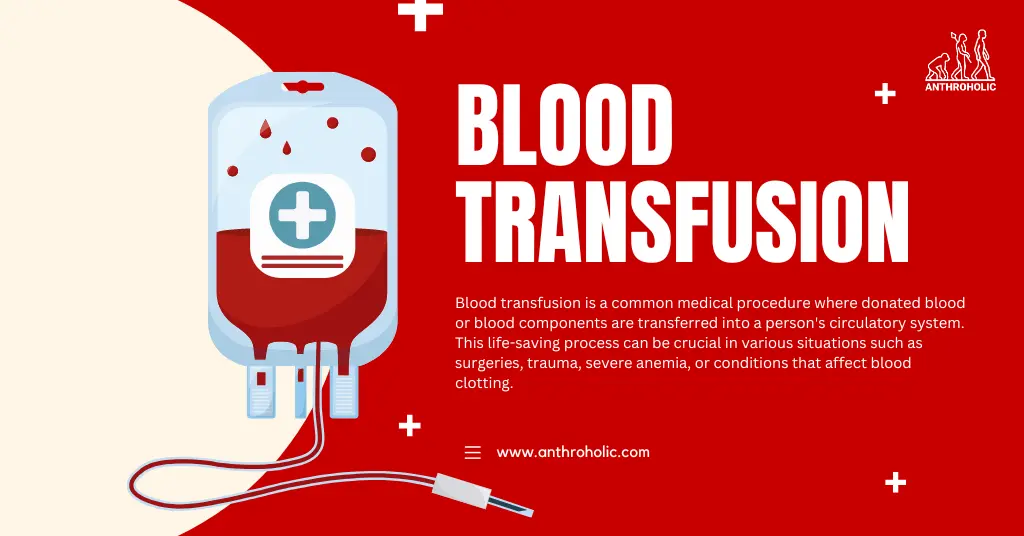AI Answer Evaluation Platform Live Now. Try Free Answer Evaluation Now
Blood Transfusion
Blood transfusion is a common medical procedure where donated blood or blood components are transferred into a person’s circulatory system [1]. This life-saving process can be crucial in various situations such as surgeries, trauma, severe anemia, or conditions that affect blood clotting.

Types of Blood Transfusion
Depending on the patient’s requirements, different components of the blood can be transfused. The key types are:
- Whole blood transfusion: Rarely used today, this involves transfusing all components of blood – red cells, white cells, plasma, and platelets.
- Red blood cell (RBC) transfusion: The most common type, used for treating anemia or blood loss due to trauma or surgery.
- Platelet transfusion: Administered to patients with low platelet counts or dysfunctional platelets, often seen in cancer treatments or platelet disorders.
- Plasma transfusion: Used when a patient’s blood does not clot properly.
- Cryoprecipitate transfusion: Given to patients with specific clotting factor deficiencies.
Importance of Blood Groups in Transfusion
Transfusion compatibility relies on the eight basic blood types, which are determined by the presence or absence of antigens and antibodies. The table below represents the compatible donor-recipient relationships.
| Recipient | Compatible Donor |
|---|---|
| A+ | A+, A-, O+, O- |
| O+ | O+, O- |
| B+ | B+, B-, O+, O- |
| AB+ | All groups |
| A- | A-, O- |
| O- | O- |
| B- | B-, O- |
| AB- | AB-, A-, B-, O- |
Transfusions must occur between compatible blood types to prevent immune reactions that can lead to transfusion reactions [2].
The Blood Transfusion Process
The process of a blood transfusion typically takes 1 to 4 hours, depending on the type and volume required [3]. Here are the general steps:
- Pre-transfusion Testing: This involves checking the recipient’s blood type and screening for any antibodies that may cause a reaction.
- Finding a Match: Once the recipient’s blood type is determined, a compatible donor’s blood is selected.
- Administration: A healthcare provider will clean an area on your arm and insert an intravenous (IV) line. The blood then drips from a bag through the IV into your vein.
- Monitoring: Healthcare providers closely monitor the recipient for any signs of a reaction during and after the transfusion.
Benefits and Risks of Blood Transfusion
Transfusions can save lives and improve health, but they also carry some risks.
Benefits
- Replaces lost blood during surgery or due to a severe injury.
- Provides blood components that your body cannot make on its own.
- Improves quality of life in individuals with chronic conditions.
Risks
- Allergic reactions, ranging from mild itching or fever to severe reactions.
- Transfusion reactions if the blood types are incompatible.
- Transmission of infectious diseases, although rigorous screening makes this risk very low.
Safety Measures in Blood Transfusion
Stringent safety measures are taken to ensure safe and efficient blood transfusion, including:
- Vigilant donor screening and testing to minimize risks of disease transmission [4].
- Blood typing and crossmatching to ensure compatibility [5].
- Close monitoring of the patient during and after the transfusion to detect any adverse reactions promptly.
Conclusion
Blood transfusion is an essential, life-saving medical procedure. While it comes with some risks, rigorous safety measures make the process increasingly safe and effective. The understanding of this process, from its types to the measures taken for safety, ensures better compliance and participation from patients and their caregivers.
References
[1] World Health Organization. (2021). Blood Transfusion Safety.
[2] American Red Cross. (2021). Blood Types.
[3] Mayo Clinic. (2021). Blood transfusion.
[4] FDA. (2021). Screening Donated Blood.
[5] NHS. (2021). Blood groups and compatibility.




